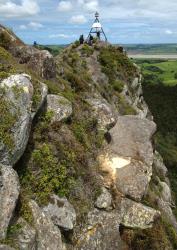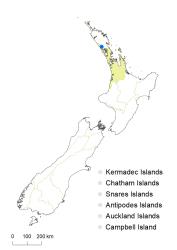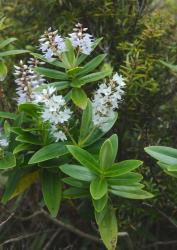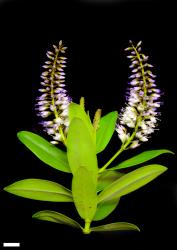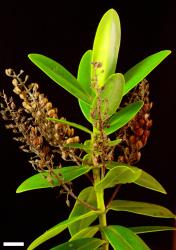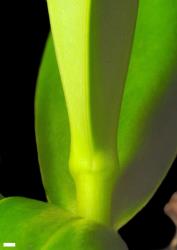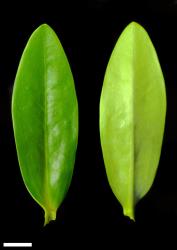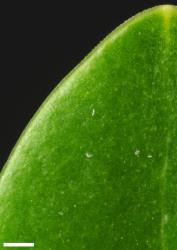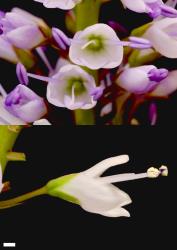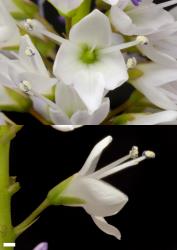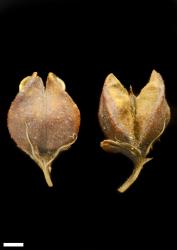- ≡ Hebe saxicola de Lange in de Lange & Rolfe, New Zealand J. Bot. 46: 534 (2008)
Compact shrub to 1 m tall. Stems erect, usually glabrous, rarely bifarious-puberulent. Leaf bud distinct, its leaves appressed at margins until fully grown; sinus absent. Leaves opposite-decussate, erecto-patent to spreading; lamina coriaceous, lanceolate to elliptic or broadly elliptic to oblanceolate, 25–80 mm long, 8–24 mm wide, dull, olive-green or dark green above, pale green beneath; midrib and (rarely) faint secondary veins evident; surfaces glabrous except for minute eglandular hairs near base above; margin glabrous, entire; apex acute; base cuneate; petiole indistinct, winged, 2–4 mm long. Inflorescence a lateral raceme, 20–120 mm long; flowers crowded, 20–130, all bisexual; bracts alternate, linear-lanceolate to lanceolate, < pedicels; pedicels erecto-patent to spreading, 2–5, rarely to 8 mm long, minutely puberulent all around. Calyx lobes 4, acute, 2.3–3.5 mm long, sub-equal, glabrous or minutely glandular-hairy on faces, mixed glandular- and eglandular ciliolate. Corolla 5–8 mm diameter; tube white, 1.0–1.5 mm long, < calyx, usually glabrous inside, rarely a few hairs near the base; lobes 4, pale purplish, fading white, erect to sub-erect, sub-equal, broadly lanceolate to ovate, 4.2–6.3 mm long, sub-acute or bluntly acute; nectar guides absent. Stamen filaments 8–14 mm long; anthers pale purplish. Style glabrous, 8–12 mm long. Capsules latiseptate, acute to obtuse, glabrous, 3.5–4.3 mm long, 3.2–3.9 mm at widest point. Seeds ovate to discoid, flattened, slightly papillate, pale brown, 1.4–1.8 mm long.
adamsii | macrocarpa | perbella | saxicola | |
|---|---|---|---|---|
Stem hairs | uniformly to bifariously puberulent or glabrous | uniformly to bifariously puberulent | glabrous | usually glabrous or rarely bifarious-puberulent |
Leaf bud sinus | present | absent | absent | absent |
Lamina (above) | glossy | glossy | glossy | dull |
Calyx colour | dark green or bronze-green | yellow-green | pink, reddish, violet, or red- to brown-green | yellowish- to dark green |
Calyx lobes outer surface | minute sessile glands | glabrous or eglandular-puberulent | minute sessile glands | minute sessile glands |
Corolla colour | white to mauve, rarely violet | white, rarely lilac, sometimes tinged lilac or pink | violet-red, violet, pink, deep mauve, very rarely carmine | pale lavender (rarely lilac) |
Corolla tube | ≤ calyx; hairy inside | > calyx; hairy inside | ≤ calyx; hairy inside | < calyx; glabrous inside |
Corolla lobes | subacute | obtuse to rounded | acute | subacute or bluntly acute |
Capsule | glabrous | glabrous | glabrous except for a few short hairs along septal grooves | glabrous |
Distribution | far North, known only from four sites, all within 1 km2, west of Spirits Bay | southern Northland from Whangārei and southern Kaipara Harbour southwards to South Auckland, Coromandel, and near Kawhia | western Northland between Ahipara and Waima Forest | known only from Maungaraho Rock, near Dargaville |
North Island: Auckland (Maungaraho Rock only, about 14 km south-east of Dargaville, only).
Open surfaces on rock outcrops: cliffs, ledges, crevices, sometimes in fringes of scrub and often with large plants of Astelia solandri, Collospermum hastatum, Dianella nigra, and grasses. Recorded elevations range from 120 to 221 m.
Flowers: September–November; fruits: December–February.
2n = 40 (see de Lange & Rolfe 2008, as Hebe saxicola).
Veronica saxicola is classified in V. subg. Pseudoveronica sect. Hebe and the informal group “Occlusae” (Albach & Meudt 2010; Bayly & Kellow 2006). It was included under V. perbella by Bayly and Kellow (2006, as Hebe perbella).



